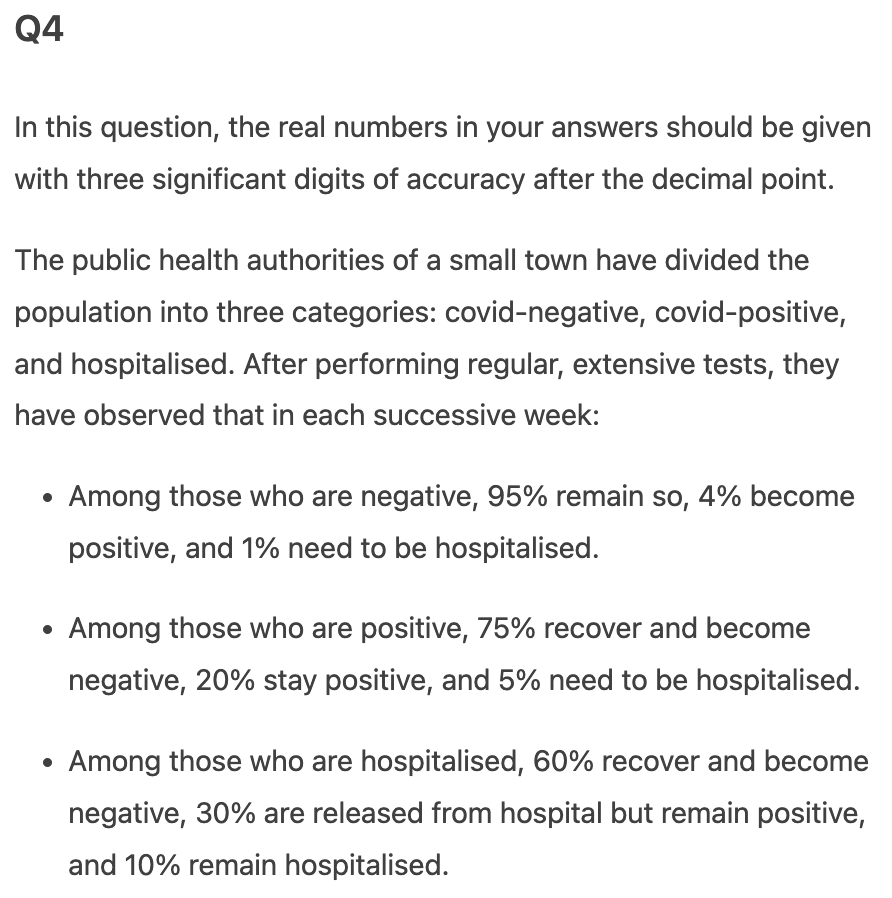Q4 In this question, the real numbers in your answers should be given with three significant digits of accuracy after the decimal point. The public health authorities of a small town have divided the population into three categories: covid-negative, covid-positive, and hospitalised. After performing regular, extensive tests, they have observed that in each successive week: Among those who are negative, 95% remain so, 4% become positive, and 1% need to be hospitalised. Among those who are positive, 75% recover and become negative, 20% stay positive, and 5% need to be hospitalised. Among those who are hospitalised, 60% recover and become negative, 30% are released from hospital but remain positive, and 10% remain hospitalised.
Q4 In this question, the real numbers in your answers should be given with three significant digits of accuracy after the decimal point. The public health authorities of a small town have divided the population into three categories: covid-negative, covid-positive, and hospitalised. After performing regular, extensive tests, they have observed that in each successive week: Among those who are negative, 95% remain so, 4% become positive, and 1% need to be hospitalised. Among those who are positive, 75% recover and become negative, 20% stay positive, and 5% need to be hospitalised. Among those who are hospitalised, 60% recover and become negative, 30% are released from hospital but remain positive, and 10% remain hospitalised.
Glencoe Algebra 1, Student Edition, 9780079039897, 0079039898, 2018
18th Edition
ISBN:9780079039897
Author:Carter
Publisher:Carter
Chapter10: Statistics
Section10.1: Measures Of Center
Problem 14PPS
Related questions
Question
![(a) After representing the population in a given week as a column
vector v =
[n; p; h], where n, p, and h represent the number of
people in the population who are negative, positive, and
hospitalised respectively, write down a matrix M for which
[n', p', h'] = M[n; p; h], where [n', p' , h'] represents the
column vector of negative, positive, and hospitalised members of
the population in the following week.](/v2/_next/image?url=https%3A%2F%2Fcontent.bartleby.com%2Fqna-images%2Fquestion%2Fb90e355c-abe9-45d7-b8d1-631ace6b1e69%2F3947e156-0e48-4e4c-bbde-4295eb150a59%2F3eiby2n_processed.png&w=3840&q=75)
Transcribed Image Text:(a) After representing the population in a given week as a column
vector v =
[n; p; h], where n, p, and h represent the number of
people in the population who are negative, positive, and
hospitalised respectively, write down a matrix M for which
[n', p', h'] = M[n; p; h], where [n', p' , h'] represents the
column vector of negative, positive, and hospitalised members of
the population in the following week.

Transcribed Image Text:Q4
In this question, the real numbers in your answers should be given
with three significant digits of accuracy after the decimal point.
The public health authorities of a small town have divided the
population into three categories: covid-negative, covid-positive,
and hospitalised. After performing regular, extensive tests, they
have observed that in each successive week:
Among those who are negative, 95% remain so, 4% become
positive, and 1% need to be hospitalised.
Among those who are positive, 75% recover and become
negative, 20% stay positive, and 5% need to be hospitalised.
Among those who are hospitalised, 60% recover and become
negative, 30% are released from hospital but remain positive,
and 10% remain hospitalised.
Expert Solution
This question has been solved!
Explore an expertly crafted, step-by-step solution for a thorough understanding of key concepts.
Step by step
Solved in 2 steps

Recommended textbooks for you

Glencoe Algebra 1, Student Edition, 9780079039897…
Algebra
ISBN:
9780079039897
Author:
Carter
Publisher:
McGraw Hill

Mathematics For Machine Technology
Advanced Math
ISBN:
9781337798310
Author:
Peterson, John.
Publisher:
Cengage Learning,

Algebra & Trigonometry with Analytic Geometry
Algebra
ISBN:
9781133382119
Author:
Swokowski
Publisher:
Cengage

Glencoe Algebra 1, Student Edition, 9780079039897…
Algebra
ISBN:
9780079039897
Author:
Carter
Publisher:
McGraw Hill

Mathematics For Machine Technology
Advanced Math
ISBN:
9781337798310
Author:
Peterson, John.
Publisher:
Cengage Learning,

Algebra & Trigonometry with Analytic Geometry
Algebra
ISBN:
9781133382119
Author:
Swokowski
Publisher:
Cengage